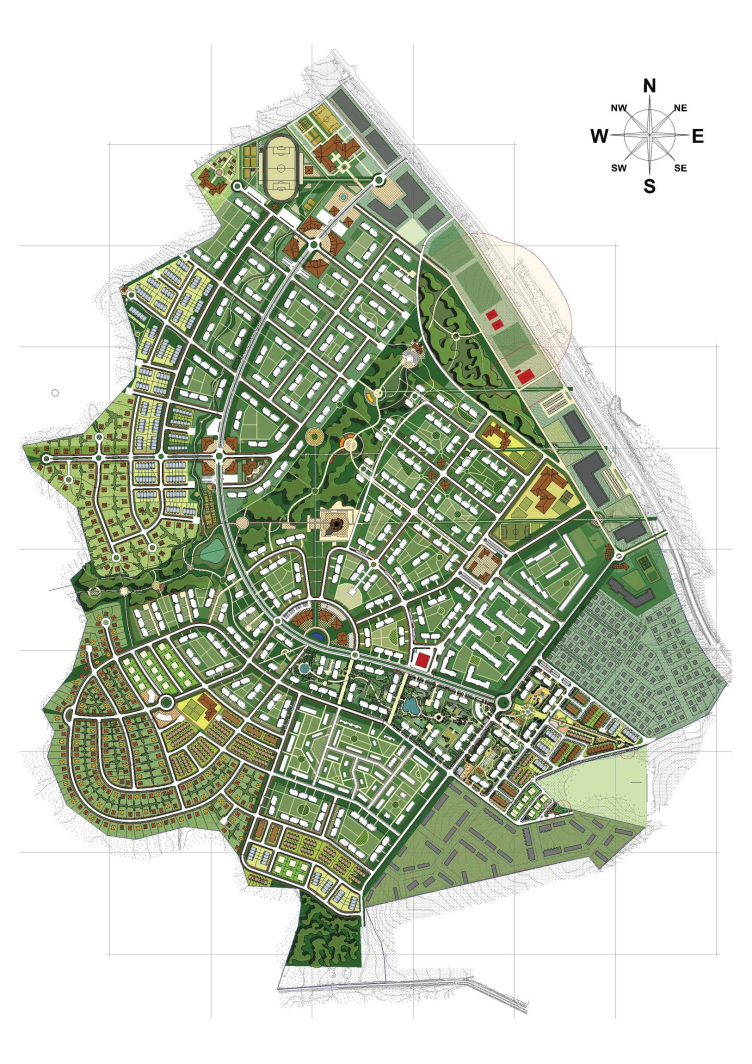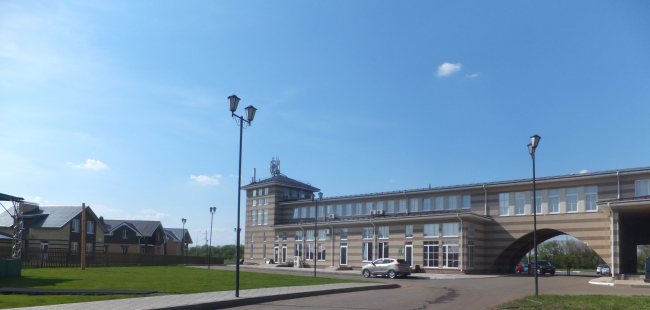
"Ekodolye" Settlement, Orenburg © "Arkhstroydesign ASD"
For "Arkhstroydesign", the past year turned to be a very productive one indeed: the team of architects lead by Aleksey Ivanov got several commissions to develop master plans for large-scale residential areas. And, even though the designed settlements are different in their size, landscape, and geography, the architect sees a lot of common among them. "What is really in demand now is the rational urban planning that gracefully ties in the rigorous economic factors and the urge to create a thought-out environment that is comfortable to live in" - he explains. How these principles were implemented in every specific project, Aleksey Ivanov shared with Archi.ru.
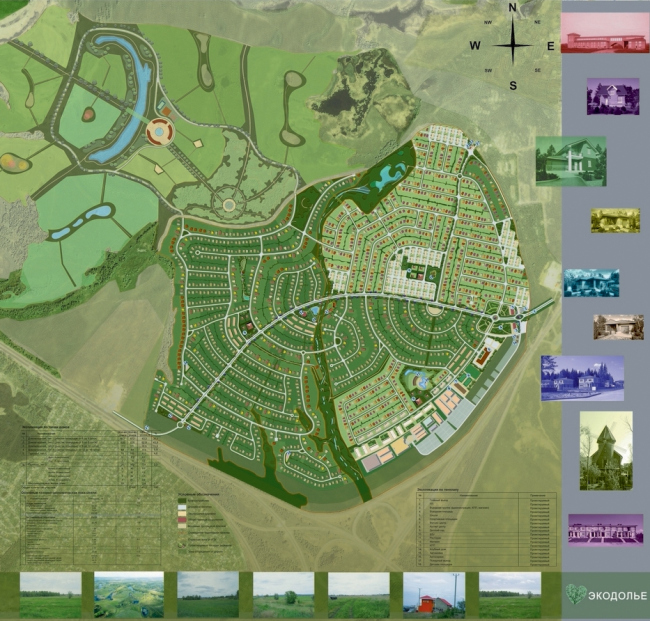
"Ekodolye" Settlement, Samara Region © "Arkhstroydesign ASD"
"Ekodolye" ("Eco-Valley" - translator's note), Samara Region, 329 hectares
- This project has a budget so tight that initially we thought that any "frills" were completely out of the question. We were to forget from the very start about the "liberties" in the form of straggling parks or creating a broad "fork" over the areas of the land sites. Upon carefully studying the peculiarities of this sight, however, and putting a certain spin on them, we were ultimately able to design for the future settlement a rather large number of recreational areas and public territories.
On the plan, the land site has the shape of an almost perfect oval, only its western border is a bit more on the winding side. Diagonally, it is pierced by a ravine with a brook running at its bottom and flowing into the Sok River, while on the outside radius it is skirted by a highway. This was what prompted the planning idea: through the territory of the settlement, we run the arch of the road that is meant to connect the two exits to the highway. This arch crosses the brook in the conditional center of the territory, thus dividing it into four virtually equal segments, which, on the one side, conditioned the construction priorities of the project, and, on the other side, allowed for introducing into the tissue of the settlement a self-sufficient green-and-blue axis that is completely traffic-free - the boulevards running along the landscaped embankments. The main arc of the road predestined the pattern for all the other secondary roads: we do not use here the rigid orthogonal grid, opting for the smooth curves and ovals. The advantages of such a plan are hard to overestimate: within the settlement, the perspectives constantly change, and, in fact, each estate can boast a unique view of its own to the nearest surroundings and the scenery that spreads out there.
What is also important is the fact that such planning concept allowed us to avert almost all of the land sites from the main road - all the houses here face either this or that secondary road, while the main road is isolated from the cottages with green areas - which ensures peace and privacy to the people who will ultimately live here. The architects were also able to gracefully set off different types of housing here: along the highway, they place the public functions and the logistic complexes, after them there are these sectional medium-rise houses, and then there are townhouses and other buildings. The public centers are located at the settlement's every keystone, plus near the densely built spots. The recreational and the social centers, on the other hand, are "scattered" all over the area so as to give its every district a public space of its very own.
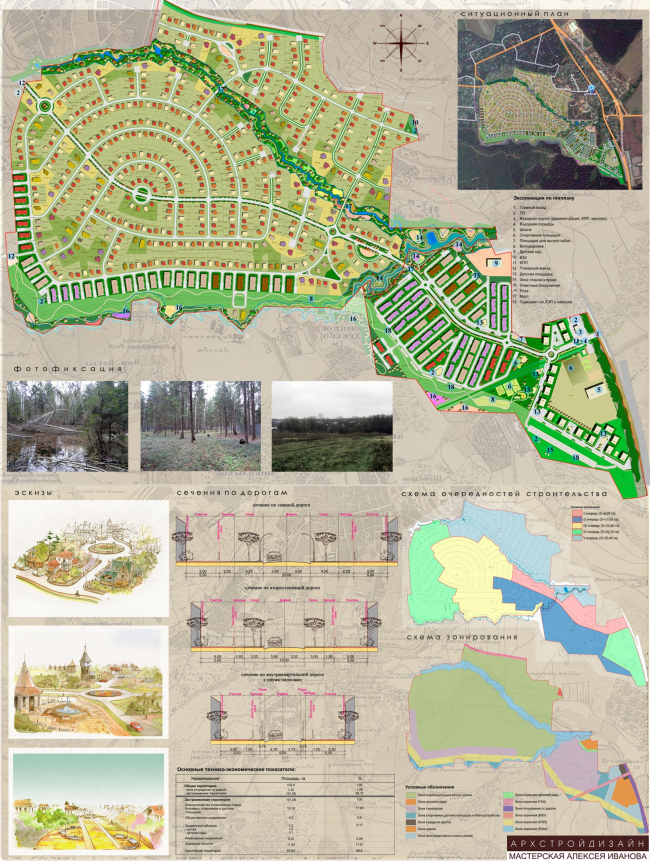
"Ekodolye Sholokhovo" Settlement, Moscow Region © "Arkhstroydesign ASD"
"Ekodolye Sholokhovo" Settlement, Moscow Region, 102 hectares
- This settlement is located but 15 kilometers away from Moscow, down the Dmitrovskoe Highway. Its very name lets one guess that this is the same customer as in the previous case, so it is not surprising that the project is based on similar principles. The master plans even turned out somewhat similar to each other, or at least this is the first impression that they produce, thanks to the arches of the two "in-settlement" roads. They perfectly fit the existing terrain - so the architects did not even have to "come up with" anything new in this case. This place also has a river whose smooth bend we offset with the arc of the main road. In this case, though, they are facing one another, so the central part of the settlement looks like a conditional "fish" when you look at its layout.
The "fish" even has a tail - the site falls into two unequal parts, the smaller of which adjoins the highway and has a diamond shape on the plan. At this spot, we organize the entrance group with all the necessary public and commercial functions, and, on the same territory, we concentrate the entire social infrastructure: the kindergarten, the sports grounds, the school, the community center, and the sectional medium-rise buildings.
And as for the part of the site that adjoins the river, it is predictably given to the individual houses. Here we also broke from tradition a bit, though, placing along the forest edge townhouses instead of villas - this was done to attract the mass buyer. The main arc of the road in this part of the settlement serves as a string on which we "hang" a few circular-layout areas - these are roundabouts, and landmark places that are meant to make each part of the settlement more recognizable. There are also small green squares that will give the settlement a fair share of coziness and privacy. The river, together with its ravines, will also be turned into a recreation area, also serving as the natural zoning element and something that will determine the construction phases.

"Dream" Settlement, Moscow Region © "Arkhstroydesign ASD"
"Mechta" ("Dream") Settlement, Moscow Region, 222 hectares
- This villa community is being built between the Dmitrovskoe and the Leningrad highways, 23 kilometers away from the Moscow Ring Road. One of its features is the fact that it has in it a maximally broad range of housing - you will see here compact and two-level apartments, townhouses and duplexes, as well as villas of various square footages. This was the customer's main requirement who was deliberately going to bring to the market a multi-format product - this is one of our primary objectives was coming up with a master plan that would allow for such "peaceful coexistence".
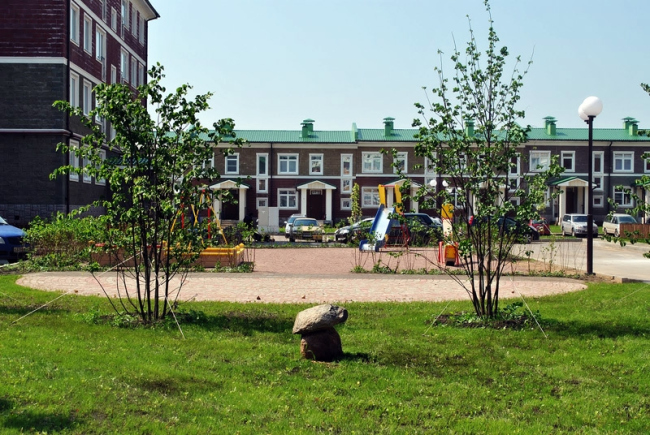
"Dream" Settlement, Moscow Region © "Arkhstroydesign ASD"
On the plan, the land site has the shape of a complex polygon that has by one "long" side - it is here that it adjoins the highway. The idea of the main "arched axis" that, together with the highway, would look somewhat like an angle protractor was also suggesting itself - but in this case we string upon in separate residential clusters. These are separated by the green zone - a small park that connects the road to the main forest, on the edge of which this settlement is being built. Through this park, we run a boulevard that we make deliberately winding - connecting the various public spaces and centers it offers and unconventional walking route that we thought would be a lot more interesting than just a straightforward "shooting-through" to the woodland. Plus - each cluster gets a public center of its own, together with a pedestrian square and a cultural object.
Working on this project, I would often recall the words of Francesco Milizia "The plan of the city must be positioned in such a way that the beauty of the whole would be divided into an infinite number of endless beauties, so different that they never once repeat themselves". And I think that we have been able to build, if not a city, then a fairly large settlement in full accordance with these principles. In particular, we paid a lot of attention to designing the residential quarters as such - totally, we developed about a dozen types which ensures the visual variety of "Mechta".
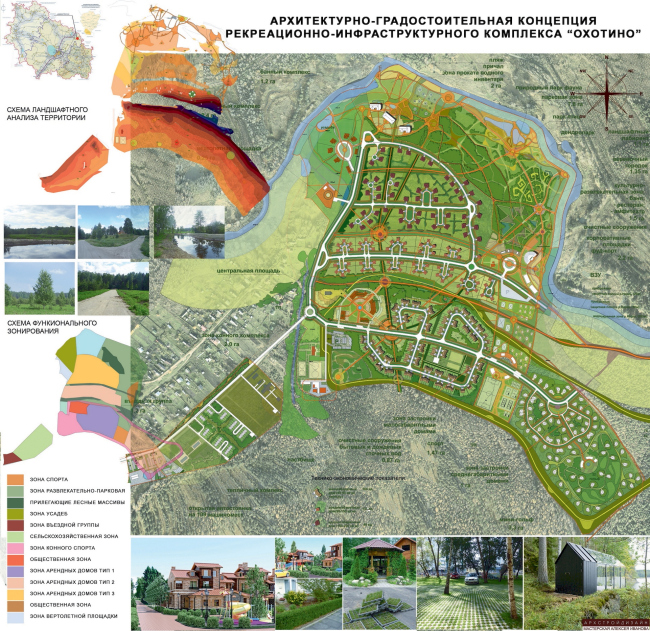
"Okhotino" Settlement, Tver Region © "Arkhstroydesign ASD"
Okhotino, Yaroslavl Region, 80 hectares
- This settlement is located 145 kilometers away from Moscow, on the bank of the Nerl River, surrounded by the almost-virgin leaves and pine forests. For us, this project became the exposure to a new format of a countryside settlement - because although there are sites of individual residential housing, the residential function as such is far from dominant here. Here, the houses from the start were built for "renting out", so, this is rather a settlement of a recreational type - we were to lay the main stress on the entertainment and sports infrastructure, providing it in as broad range as possible.
Analyzing the western analogues, we came to a conclusion that the sport resorts as such are not in great demand, really - the people who live in the contemporary megalopolises get so tired of their noise, constant rush, and information flow that they primarily look for the opportunities to relax in the first place. The settlement and its surrounding lend themselves to that, so we paid special attention to designing the pedestrian and equestrian routes, spots for meditation, as well as the objects of rural tourism. The challenge that we had to face was the fact that by the moment that we actually entered into our project, the territory of the future settlement already had in it the wood clearings of the future roads. In fact, we had to deal with the existing road grid, and it was definitely far from perfect. We think that our main achievement in this situation was being able to maximally relieve the bank area - in fact, there is only one recreation zone running along the river, and here I am not speaking about the water protection zone but about a much broader "belt" that turns the rivage into a sanctuary of sorts, a place where you can touch the magnificence of the nature but where you cannot be the absolute master of things. The project was not quite a success because we never were able to get across to our customer the planning subtleties that made the private housing from the resort type. In the latter case, you have to do something closer to Disneyland, and our project turned out to be on the boring side.
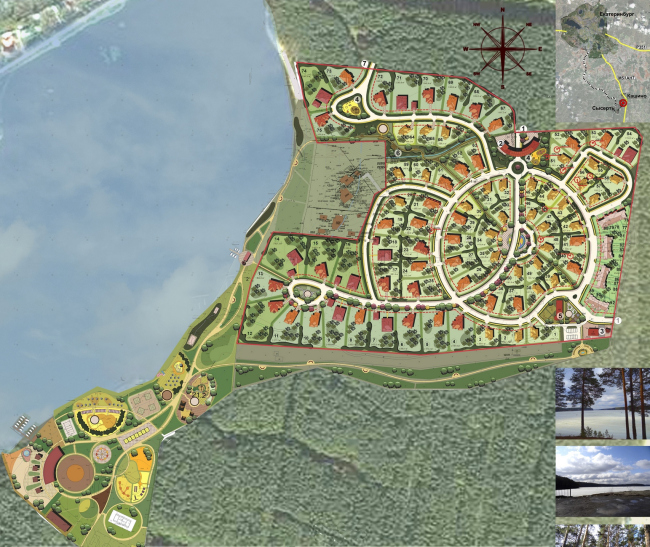
"Adagio Houses", Sverdlovsk Region © "Arkhstroydesign ASD"
"Adagio Houses", Sverdlovsk Region, 182 hectares
- Yet another project that we would want to feature today stands apart from the rest. First of all, due to the fact that it belongs on a different price segment: "Adagio Houses" is a premium-class project and it was important to highlight its status when designing it. It is situated in Sverdlovsk Region, on the bank of the Ilinskoe Lake, 30 kilometers away from Yekaterinburg. The first thing that we did was think out and design a highly developed community center that was in effect a whole landscaped block on the lake shore that offered most diverse scenarios of recreational activities, including those of the family type. This block stands a little bit apart from the rest of the settlement, and this has to do with the features of the land site one of "protuberances" of which is fully stretched along the water area. We decided that it would be worth it to reserve this unique place for ALL the people who would ultimately live here - and this is why we concentrated the public functions here.
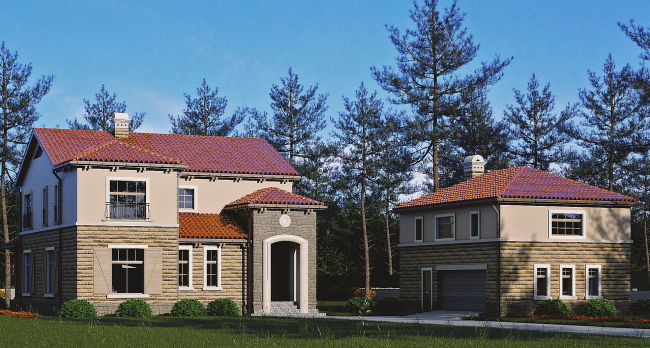
"Adagio Houses", Sverdlovsk Region © "Arkhstroydesign ASD"
As for the houses that are from 200 to 330 square meters, they are situated on the main territory of the settlement that has the shape of a rectangle that "reaches out" its broad sleeves towards the shore line. The thing is that, in this part of the bank, there are already a few residential houses, and we are virtually "embracing" this area. The planning of the resulting "sleeves" basically presents no difficulties: each of them gets two lines of houses between which we run a loop of the access driveway. Each one of them indeed ends in a roundabout - which gave us the opportunity to place a few of the sites in the immediate "visual" vicinity of the water. Plus - each of such "neighborhoods" got local public territories of its own; these will later on be marked with a fountain or a sculpture. And, as for the central part of the settlement, it is embraced by the circle of the road, so the estates are placed in a "fan-like" pattern around the landscaped area. The style of the settlement was also chosen by the customer - this is Italy - and we tried to live up to it, drawing inspiration from our favorite samples of Tuscan architecture.






